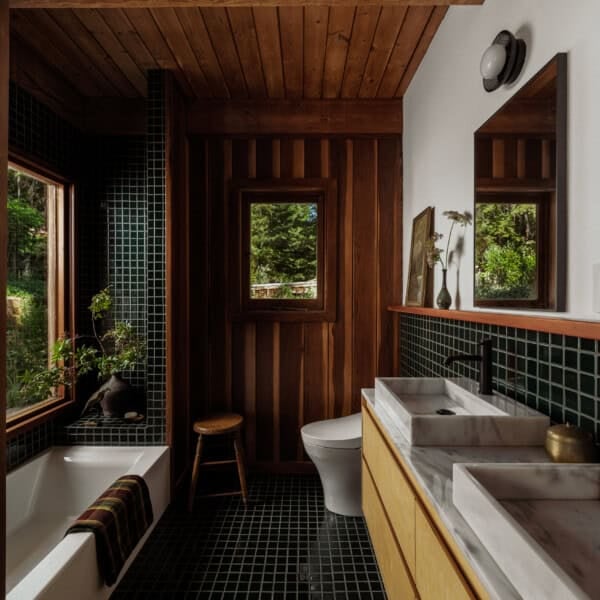Lighting is super important when it comes to home design. Proper lighting can really be the defining factor between a nice home and an aesthetically amazing one. That’s why learning the different types of lighting should be a top priority for any homeowner. Knowing how to light with purpose—enhancing ambiance and highlighting focal points along the way—will help you create a fantastic lighting design that balances form with functionality.
Table of Contents
Basic Types of Lighting: An Introduction
If you want to grasp and master the art of proper lighting then it’s important to understand the different types of lighting. Each one contributes to the overall illumination of an area, but each type serves a specific purpose in the scene.
- Ambient lighting is the dominant lighting of an area. It’s used to set the mood, soften shadows, and enhance the overall aesthetic appeal of a room. However, it remains in the background, never calling attention to itself.
- Task lighting is exactly what it sounds like: lighting that helps you achieve a specific task! Generally adjustable, this type of focused lighting is used to specifically illuminate an area where you’ll need increased visibility.
- Accent lighting is lighting that’s placed to emphasize and highlight specific points of an area. Generally, good accent lighting will provide three times as much light on the focal point than the surrounding space.
By combining these different types of lighting within my space, I’ve been able to really bring out the inner beauty of my home. It can take some trial and error, but I’m sure you’ll be able to really make your indoor space shine as well in no time at all with a little practice.
Ambient Lighting In-Depth

Now that we’ve gone over the different types of lighting, let’s dive a little deeper, starting with ambient lighting. Also known as general lighting, this is likely one of the first things you’ll notice before and after home renovations. After all, ambient lighting sets the mood for the entire room, making it an important part of interior design to get the right lighting.
Of course, the primary purpose of ambient lighting is to enhance the visibility of an area, enabling safe movement. Ceiling-mounted light fixtures, such as chandeliers, pendants, and flush mounts, are common choices for this type of lighting, as they excel at providing even light distribution and overall illumination.

I usually recommend chandeliers for more wide, open areas like living rooms, whereas pendants are best for smaller spaces. Both have plenty of styling options for you to choose from, making it easy to match the aesthetic of the room they’re in. Flush mounts, on the other hand, are great for hallways and closet spaces.
Standalone Solutions
Permanent fixtures aren’t the only way to add ambient lighting to your room, of course. Something as simple as a floor lamp can add more than enough localized general lighting to an area, provided that you use a bulb with the correct wattage. High-wattage bulbs tend to work well in living rooms, while lower-wattage bulbs can work great in a bedroom.
With most lights, it won’t be much of a concern, but you’ll want to keep the electrical requirements of each outlet in mind just the same. If you’re using a power strip and already have high-wattage items—like a home entertainment system—plugged into the same strip, then you might end up tripping the breaker by accident if you add too many high-power lights.
Just plan accordingly and you should be a-ok! A few placement tips:
- Since we’re doing ambient lighting, you’ll want to aim for even distribution. You can easily accomplish this by either using the same bulbs for different lamps, or through proper spacing.
- Select a different lamp style as needed for different spaces. It’s certainly easier to just buy multiples of the same lamp, but this can leave your various areas a little lacking in character.
- Try to find lamps with adjustable shades if possible. This makes it easy to control the amount of light in the area. Pairing shades with dimmable bulbs is even better if you can find them.
Task Lighting In-Depth

Another one of the types of lighting you’ll need to consider is task lighting. Kitchen lighting is a great example of this. When cooking, you’ll surely want to be able to see what you’re doing to avoid spills and ensure safe, painless food prep. That’s where proper task lighting can come in handy.
Similarly, this type of lighting can be applied to any other area around your home where you tend to have specific tasks at hand. Whether you have a dedicated work space, a study area, or any other area that needs targeted lighting, you’ll want to have a good task lighting setup.
Kitchen Lighting
For kitchens, under-cabinet lights are a common choice. They offer a lot of targeted illumination on the countertop, making meal prep and other kitchen tasks easier. Strip lighting can also be used for this purpose, although most LED smart light strips won’t be up to the task. You’ll need powerful light strips if you want to use them as task lighting, but it can be done (and looks amazing when done right!).
Lighting for Home Offices, Workspaces, & Study Areas
For other areas in the house, desk and floor lamps would be my top recommendations. Most lamps can be adjusted, which is great as the task at hand may not always be in the same direction. Desk lamps are excellent for focusing light on small spaces for specific activities, whereas floor lamps can be used to illuminate an entire desk with ease.
Keep Your Bills Low With LEDs
Incandescent and fluorescent bulbs may be the more traditional options, but that doesn’t mean they’re the ones you should go with. Incandescent bulbs just aren’t efficient, and fluorescent lights tend to have a shorter lifespan than the alternative, LEDs.
Honestly, I’d try to just stick with LED bulbs when possible. They last a long time, are energy efficient, and are free from annoying flickers. They do tend to cost a bit more upfront, but you’ll get this money back over time since these bulbs use 50%-60% less electricity than other options. It’s worth it.
Accent Lighting In-Depth

The last of the three main types of lights is accent lighting. This type might not be as important as the others in terms of functionality, but it’s surely worth investing in if you want to maximize the aesthetics of your home! Some decorative lighting sources, like a small wood burning stove, are the focal point, but most types of accent lighting tend to highlight something else of visual interest.
Wall sconces, recessed lighting, and track lights are all common examples of accent lighting fixtures. Wall sconces are great for focusing the viewer’s attention on a specific area, such as a piece of artwork or a sculpture. Recessed lighting is great for this as well. Since the spread of the light source will depend on the placement of the light, recessed lighting can be used to highlight anything from specific objects to entire walls. If you want even more flexibility then track lights could be a worthy investment as well.
Tip
Despite primarily focusing on function rather than form, night lights are generally considered accent lighting and work well for creating a mood, without requiring electrical work or a contractor.
A Little About the Types of Lighting for Outdoors

It’s not one of the main types of lighting, but outdoor lighting is probably something you’ll at least want to consider, especially if you enjoy spending the cooler nights outdoors. When it comes to outdoor lighting, there are two points you want to consider: safety and aesthetics.
Safety is essentially how the light benefits you. It makes it so you can see where you’re going, avoid accidents, and easily navigate. In the case of motion sensor lights, it can even help deter unwanted guests by implying a presence.
Aesthetics are just the cherry on top. You have tons of options when it comes to artificial lighting outdoors. This is true for both front yard and backyard designs. Out front, landscape lighting can be used to illuminate the entrance for guests, highlight the architecture of your home, or mark pathways. Out back, you can light hangout spaces, accent your garden, shine spotlights on impressive trees, and more.
The only limiting factor when it comes to landscape lighting is your imagination!
Other Articles You Might Love!
FAQs About the Different Types of Lighting

What are the three main types of lighting?
The main three types of lighting are ambient, task, and accent lighting.
What are the three types of continuous lighting?
Fluorescent, tungsten-halogen, and Light-emitting diode (LED) are the three common types of continuous lighting. I recommend using LEDs in your lighting system for their energy efficiency!
What are the five classification of lighting scheme?
The five lighting scheme classifications you’ll want to know are:
- Direct (downwards light)
- Indirect (upwards light that’s reflected from the ceiling)
- Semi-direct (a mixture of direct and indirect lighting)
- Semi-indirect (semi-direct lighting with an emphasis on the upwards light), and
- General lighting (also known as ambient lighting)

Lighting itself is fairly simple, but actually mastering it is a whole different story. I’m still working on it myself. I start to think that I’ve perfected my home’s lighting and then—a few Pinterest images later—I have a whole new slew of ideas to try out! Still, I love trying out different types of lighting. Now that you know a bit more about how to fine-tune your lighting to meet your needs, I hope you will too!


















One tip I forgot to add: don’t forget about dimmer switches! They’re a game changer for setting the mood, especially in living rooms and bedrooms. Also, consider bulb color temperature when choosing your lighting—warm white (2700K–3000K) creates a cozy vibe, while cooler temps (4000K+) work better for task lighting like in the kitchen or office. Thanks for the inspo!